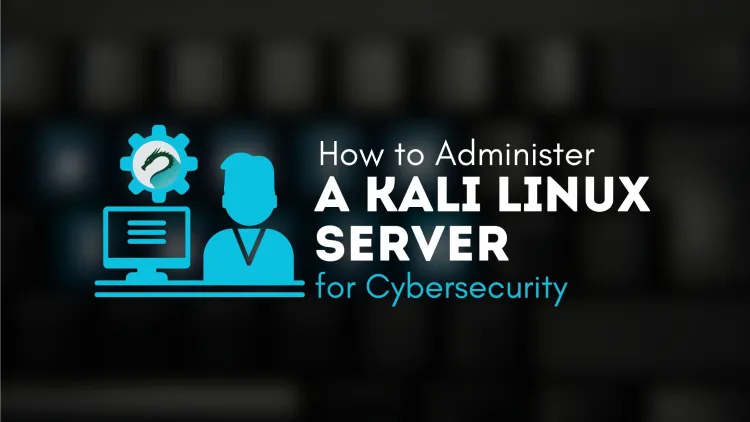How to Administer a Kali Linux Server for Cybersecurity?
Administering a Kali Linux server for cybersecurity is vital for ensuring secure and efficient operations during penetration testing and ethical hacking tasks. Key practices include updating the system, securing SSH access, managing users and permissions, configuring a firewall, and monitoring system performance. Tools like htop, tcpdump, and rsync play a crucial role in maintaining stability and security. By automating tasks and regularly auditing logs, cybersecurity professionals can optimize their Kali Linux servers for maximum performance and reliability.

Kali Linux, renowned for its cybersecurity capabilities, is widely used for penetration testing and ethical hacking. Administering a Kali Linux server effectively is crucial for leveraging its tools while maintaining security, stability, and performance. This blog outlines the essential steps and best practices to manage a Kali Linux server for cybersecurity tasks.
Why Administering a Kali Linux Server Matters
A well-administered Kali Linux server ensures:
- Optimal Performance: Smooth operation of resource-intensive cybersecurity tools.
- Enhanced Security: Protection against unauthorized access and vulnerabilities.
- Streamlined Operations: Efficient management of users, processes, and resources.
- Effective Cybersecurity Tasks: Reliable deployment of tools for penetration testing, network monitoring, and threat analysis.
Key Steps for Administering a Kali Linux Server
1. Initial Server Setup
-
Update the System:
Keep the server updated to ensure all tools and packages are secure and functional. -
Configure SSH Access:
Enable secure remote access by configuring the SSH service. -
Set Up a Firewall:
Useufwto configure basic firewall rules.
2. User and Role Management
-
Create Dedicated Users:
Avoid running tasks as the root user; create separate users for specific tasks. -
Manage User Permissions:
Use thesudocommand to grant administrative privileges to users when needed. -
Use Groups for Access Control:
Assign users to groups to streamline permissions.
3. Network Configuration
-
Monitor Network Traffic:
Tools liketcpdumpandWiresharkhelp analyze network traffic. -
Secure Network Services:
Disable unused services to minimize the attack surface. -
Set Up Intrusion Detection:
Deploy tools like Snort or Suricata to monitor for suspicious activity.
4. Managing Processes and Resources
-
Monitor System Performance:
Usetoporhtopto identify resource-heavy processes. -
Automate Tasks with Cron Jobs:
Schedule repetitive tasks, such as backups or updates.
5. Securing the Server
-
Enable SELinux or AppArmor:
Add an extra layer of security by configuring Mandatory Access Control (MAC). -
Encrypt Sensitive Data:
Use tools like GnuPG for encrypting files. -
Enable Fail2Ban:
Protect the server from brute-force attacks.
6. Installing and Managing Cybersecurity Tools
-
Install Essential Tools:
Use Kali Linux’s package manager to install tools like Nmap, Metasploit, and Nikto. -
Organize Tools with Custom Scripts:
Create scripts to automate tool deployment and testing workflows. -
Update Cybersecurity Tools Regularly:
Keep tools updated to the latest versions for optimal functionality and security.
7. Backup and Recovery
-
Set Up Regular Backups:
Usersyncto back up critical data. -
Create Recovery Plans:
Test disaster recovery procedures to ensure minimal downtime in case of an issue.
8. Logging and Auditing
-
Enable System Logs:
Usejournalctland/var/logto review logs. -
Deploy Log Monitoring Tools:
Tools like Logwatch or ELK Stack can help in analyzing and managing logs effectively.
Common Commands for Administering Kali Linux Server
| Task | Command | Description |
|---|---|---|
| Update the system | sudo apt update && sudo apt upgrade |
Updates system packages. |
| Monitor processes | htop |
Real-time view of running processes. |
| Add a user | sudo adduser username |
Creates a new user account. |
| Set up a firewall | sudo ufw enable |
Enables the firewall. |
| Analyze network traffic | tcpdump -i eth0 |
Captures network packets. |
| Schedule a task | crontab -e |
Opens the cron editor. |
| Backup data | rsync -av /source /destination |
Copies files to a backup location. |
Conclusion
Administering a Kali Linux server for cybersecurity requires a mix of system administration skills and security best practices. By securing your server, managing users and processes, configuring the network, and optimizing performance, you can ensure a stable and efficient environment for penetration testing and ethical hacking. Regular monitoring and updates are key to maintaining a secure and reliable server. Start implementing these practices today to make the most out of your Kali Linux server!














![Top 10 Ethical Hackers in the World [2025]](https://www.webasha.com/blog/uploads/images/202408/image_100x75_66c2f983c207b.webp)








